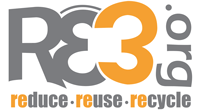
Guest Blogger – Jennifer O’Keefe, New Hanover Co. Keep America Beautiful
One of the most pervasive forms of ocean pollution comes from the very things we see on the playground or in the parking lot every day. Marine debris is any man-made object that winds up in the ocean, intentionally or unintentionally, and approximately 80% of it comes from land. The litter we see everywhere -the candy wrapper on the playground or the juice box in the parking lot – becomes marine debris when it gets washed through ditches, storm drains and creeks and ends up in the ocean. All of the litter from all over the world combines to create a significant source of ocean pollution.
Litter in any form has negative impacts such as endangering the health and safety of humans as well as wildlife. Plastic is one of the most commonly littered substances and it has some of the worst impacts. The top three items collected during the 2008 International Coastal Cleanup - cigarette butts, plastic bags and food wrappers/containers - are almost entirely plastic. While plastic will break down into smaller and smaller fragments, it won’t go away once it’s created. It just continues to degrade, making it more difficult to pick up and releasing toxic substances. Other nasty chemicals floating in the water can also adsorb onto the plastic fragments, making it even more dangerous to the animals that mistakenly eat the plastic, and those higher up on the food chain – potentially including humans. Because plastics have only been around since the 1950s we don’t really know exactly how long they’ll last, what impact they’ll have on us, or what the solutions are to clean up this problem. We do know that we are putting millions of tons of plastics into our oceans, and we live in a closed-loop system. These plastics will affect us somehow.
This summer, I went to the North Atlantic Gyre to observe marine debris in the Atlantic Ocean. Litter from our area ends up washed out to sea, and the ocean currents will eventually deposit some if not most of it into the North Atlantic Gyre.
Before boarding a research vessel based at the Bermuda Institute of Ocean Studies and headed further into the gyre, we visited a beach on the southern shore of Bermuda. The amount of plastics that had washed up from the gyre onto the beach was unbelievable. The fragments and the larger pieces were weathered; it was clear this debris had been at sea for quite awhile. We picked out 107 plastic fragments from a one- square-foot section of beach.
During the five days on the research vessel we sampled for plastics six times using a manta trawl, which skims the surface. We also collected debris as it floated by the ship. Every single one of our samples from the manta trawl contained plastics. We collected many larger items, including a motor oil bottle that had a live, eight inch long triggerfish in it. The largest item we saw, and one that poses a serious navigational hazard, was a 12-foot radar.
The bad news is that marine debris is one of the most widespread pollution problems facing the world’s oceans and waterways today. The good news is that preventing and cleaning up litter is something we can all do, and understanding the scope of the problem is the first step.
To learn more about marine debris, view photos and videos from the North Atlantic Gyre trip, or follow Bonnie Monteleone from UNCW on her trip to the North Pacific Gyre with the Algalita Foundation, go to http://www.theplasticocean.org, http://www.theplasticocean.blogspot.com, or http://www.algalita.org. Another great for information on marine debris is http://www.marinedebris.noaa.gov.
If you have a story to contribute to the RE3.org blog, just e-mail us your idea.

No comments:
Post a Comment